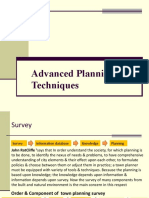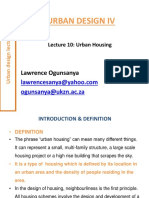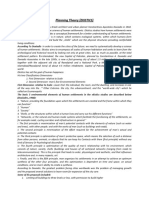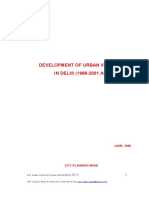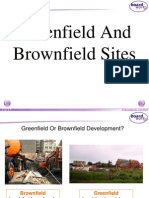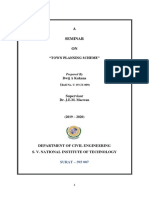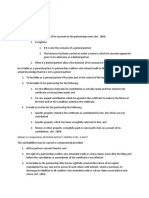0 ratings0% found this document useful (0 votes)
125 viewsUrban Renewal & Conservation
Urban renewal involves redeveloping dense urban areas through programs like redevelopment, rehabilitation, and conservation. It began in the late 19th century and experienced major growth in the 1940s. Urban renewal often involves relocating businesses and residents, demolishing structures, and using eminent domain. It aims to address issues like inadequate housing, environmental degradation, and traffic problems in cities. While early approaches focused on slum clearance, modern urban renewal emphasizes renovation and investment to improve urban areas in a way that balances development and preservation of historic character.
Uploaded by
prashinCopyright
© © All Rights Reserved
Available Formats
Download as PPTX, PDF, TXT or read online on Scribd
0 ratings0% found this document useful (0 votes)
125 viewsUrban Renewal & Conservation
Urban renewal involves redeveloping dense urban areas through programs like redevelopment, rehabilitation, and conservation. It began in the late 19th century and experienced major growth in the 1940s. Urban renewal often involves relocating businesses and residents, demolishing structures, and using eminent domain. It aims to address issues like inadequate housing, environmental degradation, and traffic problems in cities. While early approaches focused on slum clearance, modern urban renewal emphasizes renovation and investment to improve urban areas in a way that balances development and preservation of historic character.
Uploaded by
prashinCopyright
© © All Rights Reserved
Available Formats
Download as PPTX, PDF, TXT or read online on Scribd
You are on page 1/ 34
Urban Renewal & conservation
Urban renewal is a program of land redevelopment in areas of
moderate to high density urban land use.
Its modern incarnation began in the late 19th century in
developed nations and experienced an intense phase in the
late 1940s – under the rubric of reconstruction. The process
has had a major impact on many urban landscapes, and has
played an important role in the history and demographics of
cities around the world.
Urban renewal involves the relocation of businesses,
the demolition of structures, the relocation of people, and the
use of eminent domain (government purchase of property for
public purpose) as a legal instrument to take private property
for city-initiated development projects.
Many cities link the revitalization of the central business
district and gentrification of residential neighborhoods to
earlier urban renewal programs. Over time, urban renewal
evolved into a policy based less on destruction and more on
renovation and investment, and today is an integral part of
many local governments, often combined with small and big
business incentives.
Urban Renewal is of growing importance
because of:
urban areas are becoming larger and older, so more
and more renewal of urban fabric has to take place.
constant expansion of urban areas into agricultural
hinterland, while large quantities of urban land and
buildings are abandoned and left dilapidated.
Term ‘Urban Renewal’ is American in Origin
It emerged in the late 1940s (post-war) as an
attempt to revitalize central cities.
Site clearance program remained in practice
until 1960s.
Other emerging approaches came into practice
afterwards.
Urban Renewal programs are generally
undertaken by public authorities or by local
governments.
The emphasis is on those parts which have
fallen below current standards of public
acceptability. These are commonly to be found
in:
the residential parts of the inner city,
in the central business district itself.
Indicators for residential parts of inner cities
are:
inadequate housing,
environmental degradation,
presence of non-conforming uses.
Indicators for central business district are:
traffic problems,
congestion,
dilapidated buildings.
Slum Clearance
Demolition of dilapidated dwellings located in a slum
(an area of sub-standard, overcrowded housing
occupied by the poor immigrants)
Redevelopment
The demolition of an existing building and its
replacement by a new building
Rehabilitation
The repair and improvement of existing
structurally sound property
Housing Improvement
Improvements of dwellings by provision of
essential basic amenities
Conservation
To retain intact or unchanged. Also meant as
‘Preservation’
Environmental Improvements
Main emphasis is to improve environmental
conditions
Economic Renewal
Improvement of economic conditions of dwellers
Following Projects fall under Urban Renewal:
Redevelopment projects
Economic development strategies
Housing loans and other financial tools
Streetscape improvements
Transportation enhancement
Historic preservation projects
Parks and open spaces
Urban renewal, comprehensive scheme to redress a complex
of urban problems, including unsanitary, deficient, or
obsolete housing; inadequate transportation, sanitation, and
other services and facilities; haphazard land use; traffic
congestion; and the sociological correlates of urban decay,
such as crime. Early efforts usually focused on housing
reform and sanitary and public-health measures, followed by
growing emphasis on slum clearance and the relocation of
population and industry from congested areas to less-
crowded sites, as in the garden-city and new-towns
movements in Great Britain. Late 20th-century criticisms
of urban sprawl prompted new interest in the efficiencies of
urban centralization.
The 1972 World Heritage Convention has played an important
role in fostering urban historic conservation. Today, historic
cities constitute the largest heritage ‘category’ on the World
Heritage List, with over 250 inscribed sites out of more than
900. The World Heritage Committee in the past few years has
invested a considerable effort to identify the challenges for
the conservation of urban heritage and to develop
appropriate policy orientations.
In 2005 a major conference was organised in Vienna to
discuss the issue and to define a new approach. The
document that was issued by that conference, the “Vienna
Memorandum”, constituted an initial step to support the
action of the Committee and to revise the current
conservation policies.
THE ISSUES
Global processes have a direct impact on the identity and visual integrity
of historic cities and their broader setting, as well as on the people who
live in them. While some cities are growing exponentially, others are
shrinking and being radically restructured as a result of shifting
economic processes and new patterns of migration. To address these
issues, local urban strategies are becoming the key component of urban
development planning. The increasing globalization of the economy is
radically transforming many contemporary cities, benefiting some
groups, whilst marginalizing others. In some countries, centrally
controlled planning has given way to decentralization and market-
oriented approaches. The result is that cities have been exposed to new
pressures, among which the following:
Rapid urbanization threatening the sense of place and identity of
communities
Uncontrolled, poorly conceived and/or badly implemented urban
development
Intensity and speed of changes, including global warming
Unsustainable consumption of resources.
While most of the issues related to the present and future
challenges have been identified, the new Recommendation will
have to reflect a great variety of situations and stages of
evolution that historic cities face within regions, as well as in
different regions of the world. A document with universal value
will necessarily encompass the diversity of approaches and value
systems of the different cultures, and define concepts and tools
that are to be adapted to their specific contexts. The discussion
will review the main components of urban conservation and in
particular the following:
The system of values and meanings of urban heritage
Recognising the transition of the values associated to urban
heritage conservation will open the way to the definition of the
present and future value system. The historical transition of
urban heritage values from ‘monument’ to ‘social complex’ to
‘living heritage’ needs to be understood to support a new
approach.
The definition of Historic Urban Landscape
The Historic Urban Landscape is the urban settlement
understood as a historic layering of cultural and natural
values, extending beyond the notion of ‘historic centre’ or
‘ensemble’ to include the broader urban context and its
geographical setting. The Historic Urban Landscape approach
suggests that intelligent planning of the larger urban area
starts with understanding the evolution of the historic urban
landscape at this larger scale, and then seeing the current city
as a depositing of many layers over time into that setting. In
every case, the history needs to be made known and multiple
layers need to be revealed and celebrated.
THE PROCESS
In accordance with the Rules of Procedure concerning
Recommendations to Member States and International
Conventions covered by UNESCO’s Constitution, the Director-
General presented a proposal to the 35th General Conference to
prepare an international standard-setting instrument on the
conservation of historic urban landscapes. This instrument
should be developed to address the new challenges that have
emerged in the field of urban conservation since the adoption of
the last UNESCO Recommendation on heritage, i.e. the 1976
Recommendation concerning the Safeguarding and
Contemporary Role of Historic Areas. It should be emphasized
that this proposed new standard-setting instrument would not
be specific to World Heritage cities, but broadened to all historic
cities.
The Delhi Urban Art Commission was set up by
an Act of Parliament in 1973 to "advise the
Government of India in the matter of preserving,
developing and maintaining the aesthetic quality
of urban and environmental design within Delhi
and to provide advice and guidance to any local
body in respect of any project of building
operations or engineering operations or any
development proposal which affects or is like to
affect the skyline or the aesthetic quality of the
surroundings or any public amenity provided
therein"
If in the 1970s the predominant concern was about
uncontrolled high-rise development, in the 1980s issues
linked with Asian Games in the 1990s the building of Dwarka
and the freezing of the New Delhi Bungalow area, this
decade's main concerns are about four issues - the threats to
the remaining oases of open spaces, riverine and forest, the
need to improve the quality of life in historic precincts, the
need to ensure that dilapidated areas are 'redeveloped'
elegantly, and to find ways in which traffic networks can work
efficiently but with a humane quality. The DUAC took
significant initiative to highlight city-level issues in an
exhibition ‘Imagining Delhi’.
The major activities of the Commission ranged over many
issues. The new Metro lines and the Commonwealth Games
projects, and extensions to existing institutions, were
examined in the context of the underlying ecology and of
historic neighbourhoods. Agencies with overlapping
jurisdiction were invited to discussions for norms about street
furniture, and (with the cooperation of the NCT Government)
to identify ways to 'improve' Shahjahanabad. Pilot projects
initiated by DUAC, to serve as templates, include the
proposals on Khirkee Village and on Sunheri Bagh, and the
work on a Zonal Development Plan for the NDMC. Much time
and thought has been given to the pressing issues of
modifying and adding to transport-corridors. The
The Commission strongly feels that this would help in
bringing forward the best talent for the project instead of
giving predominance to financial criteria. The Commission
with the approval of the Government has taken up important
City level projects indicated below :-
Site Specific designs for wards
Rehabilitation proposals for Unauthorized colony/slums
One proposal in respect of vision for Delhi
High Rise Development Proposals Along Metro Corridors
Rejuvenation of Delhi’s Gardens
Preparation of design and prototype for high-tech public
toilets
Unified Building bye-laws for Delhi
Greater Hyderabad Municipal Corporation
(GHMC)
Hyderabad Metropolitan Development Authority
(HMDA)
Bruhat Bengaluru Mahanagara Palike
Municipal Corporation of Greater Mumbai (BMC)
Chennai Metropolitan Development Authority
(CMDA)
Kanpur Development Authority (KDA)
Delhi Development Authority
greater cochin developmet authorit (GCDA)
The 74th Constitutional Amendment Act (CAA)I incorporated
provisions for devolution of certain powers and functions to
Urban Local Bodies (ULBs).
Given the importance of functions and responsibilities
entrusted to the local self-governments, the issues relating
institutional structure of ULBs gain tremendous significance.
These structures are not uniform across states or even
metropolitan (or district) areas, and are plagued with political
and administrative problems. These shortcomings make the
successful execution of devolved functions a challenging task
for the local bodies.
functions listed in the Twelfth Schedule of the Constitution
and the ability of ULBs to carry out these functions
successfully
I. Urban planning including town planning
II. Regulation of land-use and construction of buildings:
III. Planning for economic and social development:
IV. Roads and bridges
V. Water supply for domestic, industrial and commercial
purposes:
VI. Public health, sanitation conservancy and solid waste
management:
VII. Slum improvement and up-gradation:
VIII. Urban poverty alleviation:
IX. Fire services
functions listed in the Twelfth Schedule of the Constitution
and the ability of ULBs to carry out these functions
successfully
X. Urban forestry, protection of the environment and
promotion of ecological aspects
XI. Safeguarding the interests of weaker sections of society,
including the handicapped and mentally retarded.
XII. Provision of urban amenities and facilities such as parks,
gardens, playgrounds
XIII. Promotion of cultural, educational and aesthetic aspects.
XIV. Burials and burial grounds; cremations, cremation
grounds and electric crematoriums.
XV. Cattle pounds; prevention of cruelty to animals.
functions listed in the Twelfth Schedule of the Constitution
and the ability of ULBs to carry out these functions
successfully
XVI. Vital statistics including registration of births and deaths.
XVII. Public amenities including street lighting, parking lots,
bus stops and public conveniences.
XVIII. Regulation of slaughter houses and tanneries.
Asian Development Bank (ABD)
The French development agency Agence
Francaise de Developpement (AFD)
The World Bank
Urban Infrastructure Financing is the process
by which cities obtain the right mix of
funding that they need to extend and
improve their physical infrastructure, so that
eventually all their residents have access to
adequate services.
Urban infrastructure financing combines:
(1) local government capital budget allocations;
(2) grants from state and central governments;
(3) bank and institutional loans;
(4) proceeds from long-term municipal bonds;
(5) proceeds from pooled bonds issued by urban
infrastructure funds on behalf of smaller local governments;
(6) micro-credits for the poor; and
(7) other emerging financing options, such as leveraging
municipal assets and private equity. Depending on the
creditworthiness of the local government and the commercial
viability of its projects, the mix of financing components will
vary
Government institutions
HUDCO
LIC
Support essential reforms in the urban sector of the
state
Improve the creditworthiness of local governments
Develop bankable urban infrastructure projects
Facilitate access to commercial finance and capital
markets for increased investment
Assist local governments to keep their infrastructure
projects on schedule and on budget
Reduce the cost of capital to local governments
through appropriate credit enhancements
Promote private and community participation within
urban services
Driver of urban sector reforms - the institutions are to develop and
finance urban projects, is in a good position to promote essential
reforms.
Provision of project development services – assisting local governments
to develop projects. On of the principal reasons that urban projects fail
to attract commercial finance is their weak structure that does not
identify or mitigate all the risks associated with the project.
Monitor of project implementation - For projects that have attracted
commercial finance, it is essential to ensure that there are no delays or
cost escalations during implementation. Project monitoring can be
undertaken by the institution staff or by contracting it to construction
supervision specialists that help ensure the design, contracts and
budgets all conform to approved plans.
Credit enhancement – To enable local government to access long term
capital at reasonable costs. The finance institution may create a debt
service reserve fund, purchase credit guarantees, or structure other
forms of credit enhancement.
Capital investment - in cases where local govts are unable to
access, capital markets to finance their urban projects, the
finance institution may provide direct lending. This can be
structures by utilizing grants to cross- subsidize/ lower the
interest and fees associated with commercial finance.
Provision of grants – technical assistance and subsidies will
be required to include some marginalized communities into
main stream infrastructure projects
You might also like
- Improving Interchanges: Toward Better Multimodal Railway Hubs in the People's Republic of ChinaFrom EverandImproving Interchanges: Toward Better Multimodal Railway Hubs in the People's Republic of ChinaNo ratings yet
- Singapore’s Business Park Real Estate: - Viability, Design & Planning of the Knowledge-Based Urban Development (Kbud)From EverandSingapore’s Business Park Real Estate: - Viability, Design & Planning of the Knowledge-Based Urban Development (Kbud)No ratings yet
- Marilyn Barnewall - Leo Wanta To Be Taken DownNo ratings yetMarilyn Barnewall - Leo Wanta To Be Taken Down10 pages
- The Slum Areas Improvement and Clearance Act 1956No ratings yetThe Slum Areas Improvement and Clearance Act 195610 pages
- Ar6017 Urban Housing by A Sivaraman 01 - NoNo ratings yetAr6017 Urban Housing by A Sivaraman 01 - No156 pages
- Jawaharlal Nehru Architecture and Fine Arts UniversityNo ratings yetJawaharlal Nehru Architecture and Fine Arts University9 pages
- Housing Schemes and Organizations: Description EWS LIG Mig 1 Mig 2No ratings yetHousing Schemes and Organizations: Description EWS LIG Mig 1 Mig 218 pages
- Gaurish Deshpande - Historical Evolution of PuneNo ratings yetGaurish Deshpande - Historical Evolution of Pune15 pages
- Development of Urban Villages in Delhi - 2013No ratings yetDevelopment of Urban Villages in Delhi - 2013148 pages
- Sudhar Camp, Kalkaji: Slum Redevelopment Scheme, Ward Number 196No ratings yetSudhar Camp, Kalkaji: Slum Redevelopment Scheme, Ward Number 19617 pages
- Unit 1 Introduction To Conservation: School of Architecture Ar. Roshini MuralidharaNo ratings yetUnit 1 Introduction To Conservation: School of Architecture Ar. Roshini Muralidhara55 pages
- The Unique Challenges of Planning A New Town: The Gandhinagar ExperienceNo ratings yetThe Unique Challenges of Planning A New Town: The Gandhinagar Experience17 pages
- UNIT 4-URBAN PLANNING & URBAN RENEWAL-Master Plan, Zoning, PUD100% (1)UNIT 4-URBAN PLANNING & URBAN RENEWAL-Master Plan, Zoning, PUD44 pages
- Transitioning Residential Neighbourhoods: A Case Study of Jayalaximpuram, Mysore, IndiaNo ratings yetTransitioning Residential Neighbourhoods: A Case Study of Jayalaximpuram, Mysore, India5 pages
- Urban Design Studio WRITTEN REPORT Project - GROUP 5No ratings yetUrban Design Studio WRITTEN REPORT Project - GROUP 56 pages
- Eutrophication in The Lakes of Udaipur City: A Case Study of Fateh Sagar LakeNo ratings yetEutrophication in The Lakes of Udaipur City: A Case Study of Fateh Sagar Lake4 pages
- Cp-Panchkuiyan - Architecture Case StudyNo ratings yetCp-Panchkuiyan - Architecture Case Study29 pages
- Plant Growth Classification and Disease Detection: March 14, 2019No ratings yetPlant Growth Classification and Disease Detection: March 14, 201910 pages
- M-KOPA Company Introduction_2024_Candidate PackNo ratings yetM-KOPA Company Introduction_2024_Candidate Pack19 pages
- Waiver or Compromise of Limited Partner's Liability in No. 3 and 4No ratings yetWaiver or Compromise of Limited Partner's Liability in No. 3 and 42 pages
- A Case Study On Conceptual Framework of Lending Technologies For Financing of Small and Medium Enterprises by Indian Overseas Bank PDFNo ratings yetA Case Study On Conceptual Framework of Lending Technologies For Financing of Small and Medium Enterprises by Indian Overseas Bank PDF19 pages
- 3PD Website & App Classification - 2024.03.01No ratings yet3PD Website & App Classification - 2024.03.0147 pages
- Financial Planning For A Small Scale UnitNo ratings yetFinancial Planning For A Small Scale Unit99 pages
- Complete Economic Revision Nots - 230309 - 104419No ratings yetComplete Economic Revision Nots - 230309 - 10441923 pages
- FIDIC, Red Book (1999) and MDB Ed Edition (Pink Book) ComparedNo ratings yetFIDIC, Red Book (1999) and MDB Ed Edition (Pink Book) Compared10 pages
- The Coming of Age of Digital Payments As A Field PP 71-79No ratings yetThe Coming of Age of Digital Payments As A Field PP 71-7917 pages
- Foundation Program 2021-22 Case Study and Report Generation CASE - 1 (Extra) Hindustan Housing CompanyNo ratings yetFoundation Program 2021-22 Case Study and Report Generation CASE - 1 (Extra) Hindustan Housing Company5 pages
- Module-2 Assignment by Aeika Career SolutionsNo ratings yetModule-2 Assignment by Aeika Career Solutions12 pages
- Paz P. Arrieta and Vitaliado Arrieta, Plaintiffs-: Meet." (Emphasis Supplied. Exh. 9-Def. Exh. 1-Pe., P. 18, FolderNo ratings yetPaz P. Arrieta and Vitaliado Arrieta, Plaintiffs-: Meet." (Emphasis Supplied. Exh. 9-Def. Exh. 1-Pe., P. 18, Folder3 pages
- Acceptance of Deposit by Companies - Firm of Practicing CompanyNo ratings yetAcceptance of Deposit by Companies - Firm of Practicing Company8 pages
- Improving Interchanges: Toward Better Multimodal Railway Hubs in the People's Republic of ChinaFrom EverandImproving Interchanges: Toward Better Multimodal Railway Hubs in the People's Republic of China
- Singapore’s Business Park Real Estate: - Viability, Design & Planning of the Knowledge-Based Urban Development (Kbud)From EverandSingapore’s Business Park Real Estate: - Viability, Design & Planning of the Knowledge-Based Urban Development (Kbud)
- Jawaharlal Nehru Architecture and Fine Arts UniversityJawaharlal Nehru Architecture and Fine Arts University
- Housing Schemes and Organizations: Description EWS LIG Mig 1 Mig 2Housing Schemes and Organizations: Description EWS LIG Mig 1 Mig 2
- Sudhar Camp, Kalkaji: Slum Redevelopment Scheme, Ward Number 196Sudhar Camp, Kalkaji: Slum Redevelopment Scheme, Ward Number 196
- Unit 1 Introduction To Conservation: School of Architecture Ar. Roshini MuralidharaUnit 1 Introduction To Conservation: School of Architecture Ar. Roshini Muralidhara
- The Unique Challenges of Planning A New Town: The Gandhinagar ExperienceThe Unique Challenges of Planning A New Town: The Gandhinagar Experience
- UNIT 4-URBAN PLANNING & URBAN RENEWAL-Master Plan, Zoning, PUDUNIT 4-URBAN PLANNING & URBAN RENEWAL-Master Plan, Zoning, PUD
- Transitioning Residential Neighbourhoods: A Case Study of Jayalaximpuram, Mysore, IndiaTransitioning Residential Neighbourhoods: A Case Study of Jayalaximpuram, Mysore, India
- Urban Design Studio WRITTEN REPORT Project - GROUP 5Urban Design Studio WRITTEN REPORT Project - GROUP 5
- Eutrophication in The Lakes of Udaipur City: A Case Study of Fateh Sagar LakeEutrophication in The Lakes of Udaipur City: A Case Study of Fateh Sagar Lake
- Plant Growth Classification and Disease Detection: March 14, 2019Plant Growth Classification and Disease Detection: March 14, 2019
- Waiver or Compromise of Limited Partner's Liability in No. 3 and 4Waiver or Compromise of Limited Partner's Liability in No. 3 and 4
- A Case Study On Conceptual Framework of Lending Technologies For Financing of Small and Medium Enterprises by Indian Overseas Bank PDFA Case Study On Conceptual Framework of Lending Technologies For Financing of Small and Medium Enterprises by Indian Overseas Bank PDF
- FIDIC, Red Book (1999) and MDB Ed Edition (Pink Book) ComparedFIDIC, Red Book (1999) and MDB Ed Edition (Pink Book) Compared
- The Coming of Age of Digital Payments As A Field PP 71-79The Coming of Age of Digital Payments As A Field PP 71-79
- Foundation Program 2021-22 Case Study and Report Generation CASE - 1 (Extra) Hindustan Housing CompanyFoundation Program 2021-22 Case Study and Report Generation CASE - 1 (Extra) Hindustan Housing Company
- Paz P. Arrieta and Vitaliado Arrieta, Plaintiffs-: Meet." (Emphasis Supplied. Exh. 9-Def. Exh. 1-Pe., P. 18, FolderPaz P. Arrieta and Vitaliado Arrieta, Plaintiffs-: Meet." (Emphasis Supplied. Exh. 9-Def. Exh. 1-Pe., P. 18, Folder
- Acceptance of Deposit by Companies - Firm of Practicing CompanyAcceptance of Deposit by Companies - Firm of Practicing Company














